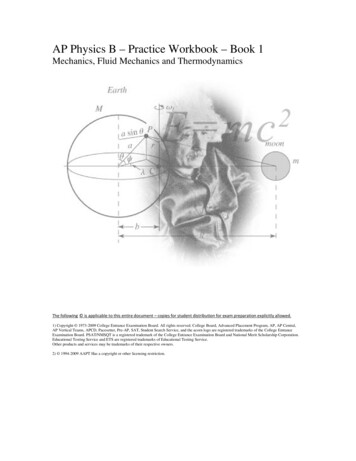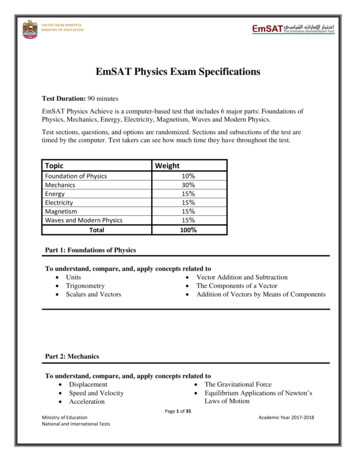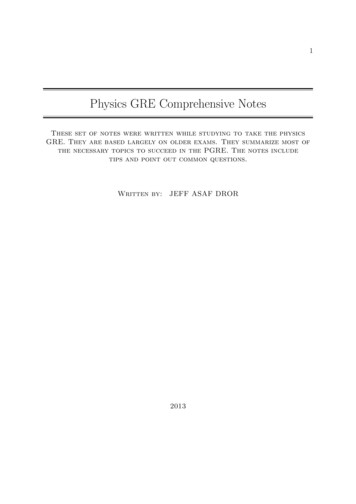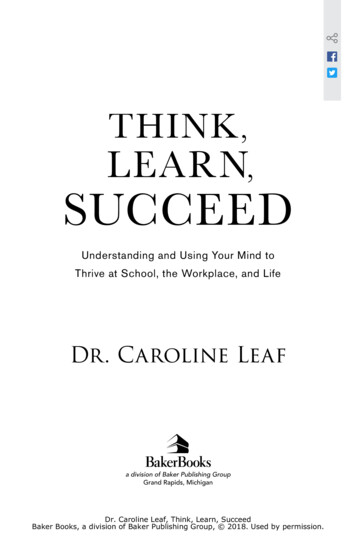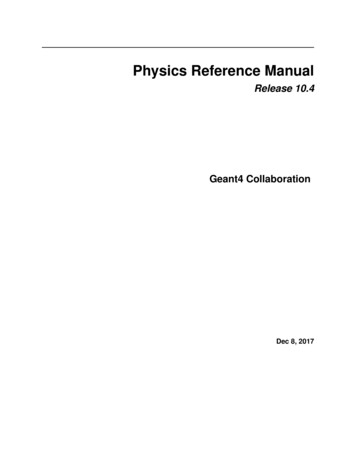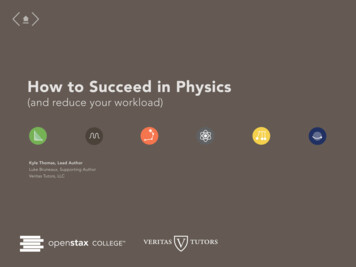
Transcription
How to Succeed in Physics(and reduce your workload)Kyle Thomas, Lead AuthorLuke Bruneaux, Supporting AuthorVeritas Tutors, LLC
How To Succeed in Physics 2About the AuthorsKyle ThomasKyle is currently a PhD candidate in the Psychology Department atHarvard University where he studies evolutionary social psychologyand serves as a teaching fellow for graduate and undergraduate courses.Kyle has primarily tutored and taught Physics and Organic Chemistrythrough the UC Santa Cruz peer tutoring program where he became aprogram administrator.About Veritas TutorsFounded by two Harvard graduates in 2005, Veritas Tutors (www.veritutors.com) is the premiere provider of educational services andproducts in the Boston area. Offering subject tutoring, standardized testpreparation, and admissions consulting, Veritas Tutors is dedicated toproviding the best possible instruction to each of its students. Workingwith educators and consultants from Harvard, Yale, Columbia, MIT, andother elite academic institutions, our students all receive personalizedguidance to achieve their goals in and out of the classroom. If youLuke Bruneauxhave any questions, comments, or concerns, please contact us at info@Luke holds a BA Summa Cum Laude from the University of Pennsylvania,veritutors.com or 1-877-265-6582.an MS from the University of Chicago and is working towards a PhDin physics at Harvard University. Luke was awarded a 2011 Derek BokCertificate of Distinction and 2011 & 2012 Harold T. White AwardsIf you are taking a physics course this semester, you may also befor teaching physics. Luke has also acted as production manager tointerested in our online Physics Crash Course. For more information ona major network television show in New York and has written andscheduling and pricing, visit www.veritutors.com/PhysicsCourse.directed several comedic theatrical productions and regularly performsimprovisational comedy. Luke has tutored clients of all levels since 2000,focusing on math and science at the high school and college level.
How To Succeed in Physics 3How To Succeed in Physics(and reduce your workload)Kyle Thomas, Lead AuthorLuke Bruneaux, Supporting AuthorVeritas Tutors, LLCAugust 2012, Veritas Tutors, LLCSOME RIGHTS RESERVED*This work is licensed under the Creative Commons Attribution-NonCommercialShareAlike 3.0 Unported License. To view a copy of this license, 3.0/ or send a letter to:Creative Commons444 Castro Street, Suite 900Mountain View, California, 94041, USA.First Printing—August 2012Edited by: Andrew Magliozzi*Reprinting of this material is permitted for non-commercial purposes withattribution toVeritas Tutors, LLC1132 Massachusetts Ave.Cambridge, MA 02138Phone: (877)265-6582Fax: (617)395-6603www.veritutors.com 2013 by Veritas Tutors, LLC. Textbook content produced by Veritas Tutors islicensed under a Creative CommonsAttribution 3.0 Unported License. Under thelicense, any user of this textbook or the textbook contents herein must provideproper attribution as follows: If you redistribute this textbook in a digital format (including but not limited toEPUB, PDF, and HTML), then you must insert in every page view the followingattribution: “A Veritas Tutors College textbook. Download for free at http://openstaxcollege.org/.” If you redistribute this textbook in a print format, then you must include a referenceto OpenStax on every physical page as follows: “A Veritas Tutors LLC and OpenStaxtextbook. Download for free at http://openstaxcollege. org visit http://veritutors.com.” If you redistribute part of this textbook, then you must insert in every digital formatpage view (including but not limited to EPUB, PDF, and HTML) and on everyphysical printed page: “Based on a Veritas Tutors LLC textbook.Download the original material for free from http://openstaxcollege.org/ or visithttp://veritutors.com.” If you use this textbook as a bibliographic reference, then you should cite thistextbook as follows: Veritas Tutors, "Survival Guide for College Physics." OpenStax15 Aug. 2012 s
How To Succeed in Physics 4Table of ContentsUsing Inverse Trigonometric functions to solve triangles. 22HOW TO SUCCEED IN PHYSICSPythagorean theorem. 23(and reduce your workload)The second use of trig functions:Introduction. 7Percentages, rotations, and waves. 23MATH CONCEPTS. 8WAVES. 25The ideas behind the symbols. 9Interchangeability of f, T, and ω. 25ALGEBRA. 9The wave equation. 25Techniques for simultaneous equations. 11Geometry. 21Principle 1: you need as many equations as there are unknowns. 11Demystifying π. 28The substitution method. 12Demystifying radians. 29The elimination method. 13Calculus (optional section). 30Word problems. 14No need to fear. 30Elementary word problem technique:A derivative is a rate of change. 30solving for one unknown variable. 14A derivative is the slope on a graph. 31Units and physics. 18An integral is the area under a curve. 32Principle 2: Units should be analyzed algebraically. 18Vectors and scalars. 33S-o/h C-a/h T-o/a. 21Visualizing vectors. 35Trig, meet algebra. Algebra, meet trig. 21Vectors and trigonometry. 35Using trig functions to find unknown sides. 21AlgebraWavesKinematicsEnergyMomentumRotation
How To Succeed in Physics 5Principle 3: Whenever you have a problem involving vectors,you should:. 36Cross products and dot products. 36Signs: positive and negative. 37One last word. 37PHYSICS CONCEPTS. 38Human intuitions. 39KINEMATICS. 41Basic quantities. 41Velocity and acceleration are vectors. 41Kinematics equations. 41Principle 4: Make sure you know what every variable represents . 42ENERGY. 49The mystery of energy. 49Conservation of energy. 50Energy’s many forms. 51MOMENTUM. 53Momentum is a vector. 53Momentum, impulse, and the relationship to force. 53Collisions: The confluence of energy and momentum. 54ROTATION. 56Principle 5: Rotation is just like everything else, but in a circle. 56From linear dynamics to rotational dynamics and back again. 56The first piece of the rotational puzzle:Forces are vectors. 45Circumference, distance, and radians. 57Forces are accelerations. 45Rotational analogues. 58Forces: causes and descriptions. 45Rotational kinematics. 58Superposition and free body diagrams. 46The second piece of the puzzle: Moment of inertia (I). 59Equilibrium problems. 47Why moment of inertia?. 59Centripetal forces. 47Torque (τ). 60Conclusion. 61AlgebraWavesKinematicsEnergyMomentumRotation
How To Succeed in Physics 6IntroductionThis guide will teach you a number of concepts and techniques to help youThis will not work in physics. You should aim to study like this:ace your physics class with less overall work. We place a strong emphasison understanding concepts, not just memorizing formulas and exampleproblems. This is not only a better way to learn physics, but it is actually animmensely more efficient way to learn physics, and will make the MCAT (orTime spentstudyingSAT II or GRE, etc.) much easier as well, if that’s on your horizon.First, we need to make a note here about the relationship between studyProgression throughthe quarterhabits and physics education. As you work your way through the course,each chapter will build upon the last. As a result, if you do not keep upin the beginning, you will be in serious trouble by the middle of the classIf you are diligent at the beginning and lay a solid foundation,because you will have no foundation for learning the new material. By theyou will probably actually end up studying like this:time you get to the finalexam, you will likely becompletely lost. In lots ofcourses, students tend totake it easy at the beginning,and then cram at the end:Time spentstudyingTime spentstudyingProgression throughthe quarterProgression throughthe quarterThose of you with a solid calculus background will realize that total time studying is equal to the area under that line. You will also notice that thelast graph has the smallest area, and therefore is the way to get through the course with the least work, and is also the way to assure the mostsuccess. We repeat: lay strong foundations!For more help ensuring you have mastered all of the necessary concepts for your course, sign up for the Veritas online physics crash course ematicsEnergyMomentumRotation
How To Succeed in Physics 7Math Concepts
How To Succeed in Physics 8Math ConceptsThis math review is structured to remind you how to perform some ofThe ideas behind the symbolsthe symbol manipulation involved in math, but is much more focused onThis book is going to cover math concepts that may seem very familiarteaching what these math equations mean in the context of real physicalto you; you might think about glossing over them. However, sinceexamples.physics uses math in its own special way, we believe you’ll benefit fromConnecting math to real world concepts will help you not just in physics,the review.but also in any pursuit that requires mathematical thinking (so basically,Much of math education teaches you how to manipulate symbols (foralmost any job). In any case, it is crucial to making physics easy andexample, “x” or “ϴ”). Since it’s all theoretical, math professors tend tointuitive, and cutting your workload considerably.ignore what all the symbols mean; all that matters is how the symbolswork with each other on the page.Physics is the opposite. Math is only useful to a physicist if the symbolsare tied to some real world concept. In class, however, most physicsprofessors assume that everyone already understands what the symbolsmean, and zoom right over the tation
How To Succeed in Physics 9AlgebraWe will not go over all of the basics of algebra but rather how it will beThe most basic algebraic concept is that anything can be done to anused to solve physics problems. While these might appear very simpleequation as long as it is done to both sides, and this is far and away theto you, it’s important that you know them cold. These trusty conceptsmost used technique in physics algebra. The following boxes give a fewshould always be in your tool belt.general principles you should be familiar with.Distributive Propertya (b c) ab ac and - (b a) -b -aAssociative Propertya ( b c) (a b) cCommutative Propertya b b a and ab baAlgebraWavesKinematicsFOIL: First Outside Inside Last(a b) (c d) ac ad bc bdEnergyMomentumRotation
How To Succeed in Physics 10Fraction Math(a b)cx yababcd(c/d)-ab a-bAlgebra c ad(a/b)a bcxb ayybbca dxb-a b c dBUTc ad b cadbcabWavesKinematicsEnergyMomentumRotation
How To Succeed in Physics 11Techniques for simultaneous equationsThe whole point of simultaneous equations is to solve problems like this.Simultaneous equations are multiple algebraic equations that shareunknown variables. What does that mean? Let’s look at an example:And we can.Principle 1: In order to solve a problem, you need as many equations asthere are unknowns.x–y 2How many unknowns were in the example? Two: apples (x) and oranges5x 4y 19(y). What if we had just one equation and lost the second?Both equations have an x and a y. The thing to remember here is thatx and y are related to each other in both ways. Let me illustrate with ax-y 2We know that we have two more apples than oranges. But that couldword problem:mean 5 apples and 3 oranges;x represents applesy represents oranges41 apples and 39 oranges;You have two more apples than oranges.x-y 2Apples cost 5 and oranges cost 4 . You paid 19 total for all yourapples and orange.5x 4y 19or 2 apples and 0 oranges!How many apples and oranges do you have?x ?y ?AlgebraWavesKinematicsEnergyMomentumRotation
How To Succeed in Physics 12Which one is it? We need the second equation to figure it out.Principle 1 is true of one unknown (we only need one equation), threeunknown (three equations), or 100 unknowns (100 equations!). Hopefullyyou won’t have to solve that one.So let’s solve the example above. Since we have two equations, we willbe able to solve for two unknown variables. There are two techniques tosolve multiple equations, the substitution method, and the eliminationmethod.Let’s simplify and do some algebra.10 5y 4y 1910 9y 199y 9y 1OK! We have one orange. But how do many apples do we have? Sincex–y 2The substitution methodIn the substitution method, we rearrange one equation and plug theresult into the second equation. This is most easily seen as an example,so let’s take the above equations, 5x 4y 19, and x – y 2:Start with the first equation: it’s simpler.We can replace y with 1 to get xx–1 2And simply solvex 3x–y 2Three apples and one orange. In other terms:Let’s rearrange this for x.x 3x 2 yOK. Now we can plug (2 y) wherever we see x in the other equation.y 15x 4y 195(2 y) 4y 19AlgebraWavesKinematicsEnergyMomentumRotation
How To Succeed in Physics 13The elimination methodThen we plug x 2 back into one of the original equations:In the elimination method we essentially do simple arithmetic, but usethe entire equation. The goal here is to eliminate one of the variables sothat we are left with a single one-variable equation. This is also easiest4(2) 3y 108 3y 10y 2/3We have our answer x 2 and y 2/3. That’s the goal in the eliminationto see in an example, so let’s pick two new equations:Example:method: find a way to get rid of one variable (either x or y). It’s a little4x 3y 10bit trickier, but you could also have done this with x by multiplying the2x 3y 6:second equation by 2:We’re going to line these up and subtract like you did in grade school4x 3y 102*(2x 3y) 2* (6)4x 6y 12Why does this help? Because now we can subtract out x:- (2x 3y 6)4x 3y 102x 0 y 4We can perform arithmetic on each variable and constants:x: 4-2 2- (4x 6 y 12)0x -3 y -2We get a new equationy: 3-3 0-3 y -2constants: 10- 6 4See how we produce a third equation with 0y? We can solve that for x.or y ⅔2x 0 y 4like above-- which is a good thing! When we plug y back into the first2x 4equation, we retrieve x:4x 3 (2/3) 10x 24x 8x 2It checks out!AlgebraWavesKinematicsEnergyMomentumRotation
How To Succeed in Physics 14Word problems2. Immediately write all defined variables off to the side of the page.In your tenure as a physics student, you will be be asked to solve wordproblems - a lot of them. Word problems are notoriously painful, and forThis way you can keep track of what you know and what you don’t.3. Figure out the missing variable that the problem is asking you togood reason: they ask you to think, and thinking is often painful. But ifsolve for. This can be really tricky but ask yourself: what is the writeryou get good at word problems, they can be fun - like a good workout.asking me for?We will start by discussing approaches that should help get you4. Find an equation that contains all of the known variables and thestarted. Here we will discuss the most basic techniques using algebraicunknown variable. Look at a list of formulas for the chapter. For mostprinciples.simple word problems, you can find one that will solve the problemElementary word problem technique: solving for one unknownvariableYou’ve got a paragraph in front of you with a lot of labels and numbers.You’re pretty sure there’s a vaguely worded question in there. How doimmediately. For more difficult problems, you’ll need multipleequations (see below).5. Once you have an equation that relates all the variables together,solve for the missing variable.6. Plug in the numbers and carry out the calculation. Keep all the unitsyou figure it out?1. First off, draw a picture and label everything. This will give you a clearidea of what is going on and what you need to account for. Even if there(kg, m/s, etc). together too.7. Box your answer. Graders love being told where to look.is already a figure in the book, draw your own so you can mark it up.AlgebraWavesKinematicsEnergyMomentumRotation
How To Succeed in Physics 15Let's say you are given the following problem:Step 3A spaceship launches with a constant acceleration. After 2 seconds theFind an equation with all of the variables you are given and theship has gone up 6 meters.unknown. Because you do not know the equations yet, I will list themA) What is the acceleration?here:B) What is its velocity at this point?A) v v0 atStep 1B) x v0t 1/2 at2Write all variables off to the sideC) v2 v02 2a x- we know t is 2 secondsTo solve for acceleration we should use equation B) because it containsour three known variables listed above (t, Δx, v0) and "a" so we can- we know x is 6 meters- we also know the initial velocity v0 is 0 meters per second because theship started at restSo we will put all of these in a list to the right.a x 6mStep 2v0 0 m/ssolve the equation with only one unknownTo solve for final velocity we should use equation A) for the same reasonSo your paper will look like this:A) x v0t 1/2 at2 x 6mFigure out what variable the problem is asking us to solve for. We areactually being asked to solve for two, a, and v. Generally, we will solvet 2s x 1/2 at2because v0 0, v0 t 0t and so itdrops out of the equationa 2 x/t2Plug in your numbers andyou get a 3 m/sfor them in sequential order.v0 0 m/sa 3 m/s(This is now one of our variables)B) v v0 atv atAlgebraWavesKinematicsEnergyAgain, v0 drops outPlug in your numbers and you get v 6 m/sMomentumRotation
How To Succeed in Physics 16Technique for multiple unknowns: Multiple unknowns require1. Define unknown variables. What is the problem asking for?multiple equationsNumber of jelly beans (let’s call that J) and number of M&M’s (let’sSo you’ve got a problem with two unknowns in it. We solve these wordcall that M):problems using basically the same technique as above, except here weJ ?will need to find multiple equations.M ?1. Remember our first principle: We need as many equations as we2. Write an equation using the information in the problem.We know that total candy is J M, and that we have 36 pieces so:have unknowns.2. Try to limit the number of variables! Every new variable introducedby an equation will require us to add another equation. Thus if youJ M 36.3. Check how many unknowns and how many equations you have.pick an equation that contains an additional unknown, you will needIf you don’t have enough equations, look for a way to generateanother equation, and you will not have gained anything.another one.3. The equations that we choose will have to have at least one variablein common, or else they cannot be linked together.Notice that we have two unknowns above, J and M, but only oneequation. We need another. Luckily, we know that we have twice asmany jellybeans as M & Ms, so then J must be equal to 2M, or4. To solve our set of equations we will use either the substitutionmethod or the elimination method. Typically you will use thesubstitution method because the elimination method only tends tobe helpful if both equations have the same variables.J 2M4. Solve the equations using either substitution or eliminationmethodWe will use the substitution method to solve this. Because J Let’s use a simple example to demonstrate:2M, we can just plug in 2M wherever we have a J. So J M 36You have twice as many jelly beans as you do M & Ms. You have 36 totalbecomes 2M M 36, and now we can solve because we onlypieces of candy. How many of each do you have?have one unknown in our equation:2M M 363M 36M 36/3 12AlgebraWavesKinematicsEnergyMomentumRotation
How To Succeed in Physics 17We have 12 M & Ms, to find number of jellybeans just plug thisback inJ 2MJ 2(12) 24We have 24 jellybeans and 12 M & Ms5. It is generally helpful to double-check your answer using one ofthe original equations.24 jellybeans 12 M & Ms 36 pieces of candy. AlgebraWavesKinematicsEnergyMomentumRotation
How To Succeed in Physics 18Units and physicsPrinciple 2: Units should be analyzed algebraically just as if they wereUnits give a lot of people fits. We’re talking here about the labelsvariables.you use, like kg, m, s, Newtons, Joules. Who cares, right? I just wantHere’s a great tip: Always use Standard units! By that we mean “SI”numbers!units: kilograms (for mass), meters (distance), seconds (time), NewtonsIn fact, to a physicist, units are much more important than numbers.(force), Joules (energy), and so on.Why? Because units actually tell you something about the physicsinvolved. Numbers are just digits.For example: If you are given a length in centimeters, convert it toMost students do not realize that they can perform algebra on unitsmeters immediately. If you do this, you never need to worry aboutthe same way they do algebra on variables. (You might have seen thisadding inches to centimeters, or calculating mass with pounds. Youin chemistry as “dimensional analysis”). This is the easiest way to checkcan focus on solving the problem. Then at the end, give the answer inyour work. Let’s say you get asked to solve for distance, and you give anwhatever units it’s asking for. For example, the problem might ask foranswer in seconds. Something went wrong!mass in grams, so solve for kilograms and then convert.Sounds tedious right? It can be. But it will save you a lot of time andpoints in the end. And you’ll actually learn more physics. Trust us.This is most easily shown through an example. So don’t stress now; aswith every skill, mastery comes with ion
How To Succeed in Physics 19The standard unit for energy is the Joule, which is equal to Kilogramsmultiplied by meters squared per seconds squared1 Joule Kg (m2/s2)There are many equations for energy, we will use two simple ones todemonstrate how the units will always result in JoulesK 1/2mv2 The equation for kinetic energy is thism KgThe units of mass are kilogramsv m/sThe units for velocity are meters per secondv2 m2/s2So the units for velocity squared would be meters squaredper second squaredK 1/2mv2 Kg(m2/s2) JBasic arithmetic shows the units of thevariables work out to Joules, exactly what we wantU mghAn equation for potential energy is thism KgThe units of mass are kilogramsg m/s2The units of acceleration of gravity are meters per secondssquaredh mThe units of height are meterseU mgh Kg(m/s2)m Kg (m2/s2) JAgain basic arithmetic yields Joules, exactly what you wantAlgebraWavesKinematicsEnergyMomentumRotation
How To Succeed in Physics 20TrigonometryAs seen in the the three diagrams below.Trigonometry is the mathematics of right triangles, which are trianglesTrigonometric functions can be used for many things in mathematics,with a 90 angle. This is important to realize because we will always wantbut we will deal with just two: (1) ratios in right triangles, and (2) waveto deal with right triangles, and usually these must be constructed (often functions.by inserting lines artificially) in order to use the tools presented here.The first and most important concept that you need to understand isThere are only two major concepts that you will need to be familiar with,that trig functions are ratios of different sides of a right triangle. Thesebut you need to know them inside and out:ratio values are constant for any given angle, no matter the size of the1. Trigonometric functions of sine, cosine, and tangentright triangle. As a triangle gets bigger or smaller, each side changes2. The Pythagorean theoremin an equivalent way to the others, so that even though the absoluteTip: Remember that the angles inside a triangle must always add up tovalues of the sides may change, their ratios do not. Notice in the180 , so if you know two, you can easily solve for the third.The first and most common use of trig functions: Ratiosfollowing diagram that as the x-component of the triangle doubles, andthen triples, so does the y-component, so that the ratio of the sides isconstant.The ratio is always tan 30 .58 .58/1 1.15/2 1.73/3213.5830 30 30 on
How To Succeed in Physics 21S-o/h C-a/h T-o/aalways .707, etc. Given this the equation is just an algebra function with“SohCahToa” is the mnemonic by which most people remember theirthree variables (x y/z) where one of these just happens to be a trigtrig functions. It tells us which trig function corresponds to what ratio ofsides in the right triangle.function. Let’s say we have a triangle with a known angle and one knownHypotenuse. We want to know the “opposite” side, which we’ll call y.6Hypotenusey30 OppositeΘUsing trig functions to find unknown sidesAdjacent1. Set up the equation,cos 30 y/6MnemonicTrig functionFormulaRatioSOHSineSin θ O/HOpposite over HypotenuseCAHCosineCos θ A/HAdjacent over HypotenuseTOATangentTan θ O/AOpposite overAdjacent2. Then solve for our unknown,You will not need to know the three other trig functions for basic physics(sec, csc, and cot). Whew!y 6(cos30).3. Replace the trig function with the values.cos 30 .54. Thusy 6(.5) 3Trig, meet algebra; Algebra, meet trigThe math here is actually very simple. Each trig function for any givenangle has a specific value, for example sin 30 is always 0.5, sin 45 isAlgebraWavesKinematicsEnergyMomentumRotation
How To Succeed in Physics 22Notice that as long as we are not solving for the angle, we are just doing Using Inverse Tr
How To Succeed in Physics 8 Math Concepts The ideas behind the symbols This book is going to cover math concepts that may seem very familiar to you; you might think about glossing over them. However, since physics uses math in its ow





